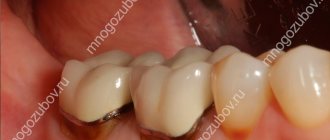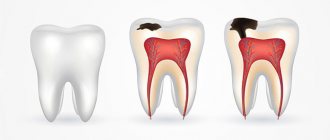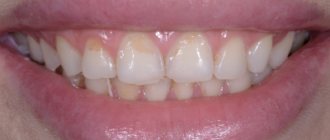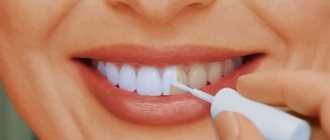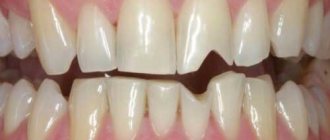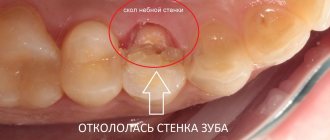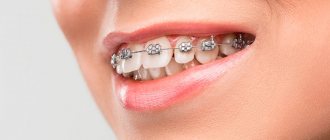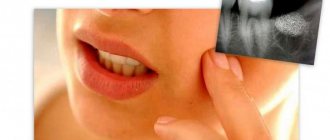What are cracked teeth? This is a violation of the integrity of the enamel, a split in the outer shell of the tooth of different shapes and depths. The tooth itself practically does not change its appearance, does not wobble and does not always hurt. A cracked tooth enamel may have the following symptoms:
- increased tooth sensitivity, severe reaction to cold and hot;
- the appearance of a dark stripe on the tooth after drinking coloring drinks - tea, coffee, wine;
- aching pain for no apparent reason;
- swelling and pain in soft tissues.
Startsmile warns: any of these symptoms is a reason to consult a doctor. He will be able to diagnose an enamel crack and take the necessary measures in time.
What is a tooth crack
This is a split in the enamel that can be quite deep or affect only the superficial layers. In this case, the unit does not have contrasting pigmentation, is not broken or loosened.
Cracked crowns cause pain. If the defect is small, only an experienced dentist can notice it during an examination. Larger damage is visible to the naked eye. They are especially visible after drinking coloring drinks (coffee, tea, soda).
Even when the crack is extremely small, mandatory medical intervention is required. A slight stripe on hard tissue increases over time, becomes deeper and leads to the loss of not only the crown part, but also the roots.
Content
- Causes of destruction
- Activities before treatment with a doctor
- Temporary filling fell out
- A permanent filling fell out
- Price
- Prevention of destruction
No one is safe from falling out or partial chipping of a filling. The patient experiences discomfort. This is both a moral component and very real inconvenience. The problem becomes the inability to chew food normally, excessive tooth sensitivity, even pain. You need to contact a specialist immediately to stop tooth decay and restore its normal functions.
PROMOTION
Dental restoration, installation of fillings
from 2200 rub.
Reasons why cracks appear in tooth enamel
There are several factors:
- Mechanical impact. The person may be hit or otherwise injured. This can also happen if you chew nuts or eat other solid foods.
- Deficiency of vitamins and minerals. When the body lacks fluoride, calcium and other essential substances, the upper layer of incisors, canines and molars becomes thinner and becomes susceptible to irritants.
- Temperature changes. This happens when you eat hot and cold at the same time.
- Bruxism. Pathology leads to deterioration of bone tissue, abrasion and destruction.
- Using pastes with abrasives. With their regular use, the lateral and front teeth crack, as if cracks appear on them, as well as scratches intersecting with each other. Large particles lead to thinning of the enamel. The protective layer wears off and can no longer perform its functions.
- Dentist's mistake. With poor quality treatment and some cosmetic manipulations, the doctor may damage the surface with instruments.
- Foods in the diet containing a large amount of acids (for example, citrus fruits, berries) and chemical dyes (sweet soda). At first, a person notices a significant increase in sensitivity.
- Taking certain medications (antibacterial drugs, etc.).
- Installation and wearing of braces.
- Smoking and other bad habits (picking your mouth with nails, hard objects).
- Insufficient hygienic care of the oral cavity.
- Bite abnormalities.
Dental injuries in the form of fractures
Chips of enamel, fractures of the coronal part with damage to the pulp, fractures of the roots - all these injuries fall into the category of “tooth fracture”. There are 3 options for fractures of primary teeth:
- if the baby tooth is slightly injured, then the doctor usually monitors its condition;
- In case of significant damage, the baby tooth is removed in order to preserve the permanent tooth germ, since the injured baby tooth becomes a source of infection. This often happens with longitudinal fractures - when the tooth cracks in half lengthwise, and it is no longer possible to save it;
- in other cases, the tooth can be saved through restoration and canal treatment. In young children, treatment is often carried out during sleep.
First aid for a tooth fracture: It is very important to collect all the tooth fragments and put them in water or milk. If you collect all the parts of the tooth and quickly, within half an hour, get to the dentist, the tooth can be restored and it will be successfully fixed in the socket. If it was not possible to collect the tooth particles, then treatment of the tooth injury is carried out:
- In case of minor damage to the enamel (chips, cracks), tooth polishing is not performed - the dentist restores the tooth by installing a filling.
- If there is severe damage to the crown of the tooth, endodontic treatment may be required to preserve the pulp and then the installation of an inlay and/or crown.
- If the root is fractured, the tooth is rigidly splinted for 3-4 months, and the dentist monitors the condition of the pulp. Sometimes it is necessary to treat the canal of a coronal fragment, but there is no need to connect the fragments with pins. The tooth can almost always be saved, since this is a sterile injury, and the treatment prognosis is favorable, and therefore it is not necessary to remove teeth with a broken root.
The peculiarities of dental prosthetics in children are the impossibility of using implants, so a lost tooth is replaced with a removable plate, an artificial tooth is fixed with fiberglass to adjacent teeth, or orthodontic mini-screws are used to fix the prosthesis with a temporary screw. Tooth replantation is also used - transplantation of a lateral tooth in place of a missing one.
Why are dental cracks dangerous?
If such a problem is discovered, the consequences can be very serious. For example, in some cases it is unavoidable to delete a unit. If treatment is not started in a timely manner, scratches under regular loads will turn into wide fractures, and the pathological process will affect deeper layers (dentin).
What is the danger:
- A damaged incisor, canine or molar is not protected from external influences. As a result, sensitivity progresses, especially if a person consumes cold, hot, sweet and sour foods. Pain is felt when biting food.
- Food particles, plaque, and pathogenic microorganisms accumulate in the cracks. This is a favorable environment for the appearance and growth of caries, periodontitis, and pulpitis.
- A frequent complication is the occurrence of chips. Because of this, injury occurs to the gums, tongue, and the inside of the cheeks. Injuries to the mucous membranes complicate symptoms and lead to deterioration of well-being.
- Loss of a unit. This is an irreversible consequence. If the crown is completely cracked and restoration is impossible, the dentist performs an extraction. Otherwise, the risk of pulp infection increases.
- The presence of psychological discomfort. A person feels unattractive due to unaesthetic small stripes on his teeth.
Classification of cracks
There are several generally accepted types of such damage in dentistry. Each of them has its own characteristics and poses a certain health hazard. Late diagnosis and treatment significantly reduces the likelihood of saving the unit.
What are the types of cracks (microcracks) on teeth:
- Vertical. The crown and deep root region are affected. If the phenomenon has spread over the entire length of the incisor, canine or molar, no restorative measures will help. The doctor performs an extraction.
- Horizontal. In the absence of therapeutic intervention, chips form. The closer to the gum the scratch is, the higher the risk of chipping.
- Inclined. The defect runs diagonally. Ignoring symptoms leads to the development of pathogenic microflora and caries.
- Internal. Not easy to detect. Detected using an x-ray. Most often, patients go to the dental clinic after a fracture caused by such a crack in the teeth (we’ll look at how to remove it and how to treat it below).
- Root. The split goes through the root. If the damage is extensive, removal cannot be avoided.
- At the base. Since the dentinal layer suffers, among other things, inflammation is observed and pain is felt.
Cracks are also divided into deep, superficial and multiple. Not all of them are accompanied by unaesthetics, so it is important to pay attention to the accompanying manifestations.
Additional symptoms
The problem is visible to the naked eye if it touches the front incisors. In other cases, most often the damaged surface is not noticeable. Therefore, patients often come to the clinic when the tissues are already severely damaged.
Auxiliary symptoms indicating a pathological process:
- pain of uncertain localization;
- increased sensitivity to hot and cold;
- discomfort when chewing food;
- unpleasant odor from the mouth;
- inflammation of the mucous membranes in the mouth;
- change in enamel shade;
- bleeding when pressing the unit.
Diagnostic methods
When the first suspicious signs appear, you should visit the dentist. Dentists not only conduct a visual examination, but also use special instruments. To determine the location and extent of tissue damage, an x-ray examination is prescribed. What to do if a crack appears inside a tooth is decided based on the results of diagnostic procedures.
Numerous scratches can be detected without the use of tools. The deep ones can only be seen under the influence of light, while the surfaces are dried with cotton balls. Superficial flaws are detected using a magnifying glass or in a special way - transillumination.
Making an accurate diagnosis can be difficult. This is due to the frequent absence of characteristic symptoms. Specialists take into account all manifestations in their entirety: the patient’s sensations, his medical history, x-rays, exacerbation of symptoms during treatment.
All methods are combined, since this way the dentist will be able to objectively assess the situation and develop a therapeutic regimen. For this we use:
- instrumental examination of the oral cavity;
- examination under a microscope;
- transillumination;
- staining with contrast agents.
In some cases, exploratory surgery is indicated. This is the exfoliation of dentin particles and the removal of granulation tissue for subsequent painting of the damaged layer. In this way, even microcracks are visualized. Sometimes root resection is performed.
Diagnosis of root cracks
When symptoms of a cracked tooth root appear, the patient comes to the clinic with unclear complaints, the doctor prescribes an examination:
- Gently tapping the crown with the instrument determines whether there are any irregularities. Examines the gums, checks for bleeding.
- Sends for an x-ray. The photo will show the appearance of the crack and its exact location.
- Sometimes an electrical impulse is used to determine the degree of damage to the neurovascular bundle (pulp).
In some cases, you will need several shots from different angles. This method will help to distinguish a crack even with a small discrepancy between the fragments. The beam must pass through the plane of the defect. Lines that are deviated from the canal axis are more noticeable, while lines that overlap the filling are practically invisible. A concomitant phenomenon is loss of bone around the problem tooth.
Treatment of horizontal and vertical cracks in tooth enamel
Therapeutic tactics are developed exclusively by a specialist based on the diagnostic results, size and localization of cracking. The most commonly used methods are:
- Remineralization. A special composition containing a large amount of calcium and fluorine is applied to the surface. As a result, the units become smooth, and increased sensitivity disappears.
- Restoration. The chipped fragment is removed and replaced with a composite overlay.
- Veneers. Suitable if the defects are shallow but numerous. Before use, it is necessary to treat caries and other pathologies.
- Crowns. Suitable for cracks along the entire length of the unit. Installed on cement or bridge.
- Depulpation. When the pulp is severely damaged, it is removed. In case of partial damage, dentists remove only the pathological elements of the nerves.
- Extraction. A radical method, it is indicated in cases where an incisor, canine or molar cannot be saved. During surgery, local anesthesia is used.
Why tooth extraction may be necessary
When a unit needs to be removed according to indications, you should not try to save it. The fact is that even with restoration, after some time you will have to remove the damaged element. However, further implantation and prosthetics may be difficult.
Getting rid of cracked parts is also carried out due to inflammation in the oral cavity. If you leave everything as is, it will negatively affect the condition of all elements.
What to do if your child’s enamel is cracked
Babies constantly put various objects into their mouths. This leads to injury to units. What do cracked teeth look like in preschool children (the causes and symptoms of the pathology are listed above)? Externally, the defect is no different from similar problems in adults, but does not cause such severe consequences.
Over time, the bite will change to permanent, so the situation should not be a cause for alarm, but it is necessary to visit a doctor in any case. Some types of damage affect the formation of root rows. And during the examination, hidden pathologies and injuries are often revealed.
If pain is present, you can give your child a mild pain reliever recommended by specialists. You also need to make sure that the baby does not put his hands in his mouth.
What to do if there is a crack in the tooth enamel of the front tooth
You can notice the problem yourself. But it is important to immediately contact your dentist to prescribe therapy. Restorative measures to strengthen the structure are preliminarily shown.
Typically, surfaces are treated with compounds containing valuable minerals. If necessary, voids are filled with polymers.
Procedure for the presence of microcracks in the front:
- cleaning the enamel layer;
- polishing and grinding;
- fluoride varnish treatment.
It is worth taking care in advance about the absence of oral diseases. Otherwise, the inside of the units may become infected, causing them to eventually crack.
What to do if a crack appears on a tooth - help at home
Attempts to independently restore the integrity of the scratched layer will not bring any results. If done incorrectly, it will affect neighboring units. Treatment should be carried out by a doctor.
At home, it is recommended to treat the surface with an antiseptic solution. This prevents the development of the inflammatory process. If there is pain and other unpleasant sensations, drugs with an anesthetic effect are indicated.
It is important to refrain from eating before seeing a specialist. When this is not possible, chew food on the healthy side. If the defect is deep, brushing should not be done until visiting a doctor.
Diagnosis methods
When the first symptoms of pathology appear, you should consult a doctor. If you suspect the presence of microcracks in the enamel, the dentist will conduct a microscopic examination of the dentition and identify the defects present on it. During diagnosis, the doctor can use a special dye that can reveal even the smallest cracks.
During the study, the doctor collects anamnesis from the patient’s words and data from his medical card in order to identify the cause of the formation of cracks in the teeth. Studying the patient's medical history will help the doctor distinguish pathology from other diseases and determine the need for more serious diagnostics to identify internal splits in dental tissue.
In addition to the above, the dentist evaluates the condition of the soft tissues of the oral cavity. Swollen gums indicate dental problems.
After a visual examination, the patient may be given a special dental brush. It is similar to a regular toothbrush, but does not have bristles. A person must bite it daily (with a new tooth every day) and record his sensations. The dental unit that is most cracked will give the most painful reaction to the experiment.
If internal fractures are suspected, an x-ray of the jaw is performed. It helps to identify old defects and cracks in tooth roots.
Cracks when wearing braces or after removing them
Damage can appear even after the most harmless procedures. For example, this applies to bleaching. Long-term use of an orthodontic system also leads to deterioration of the enamel layer. For this reason, after a therapeutic course, restorative remineralizing therapy is indicated.
To prevent the design from causing scratches, you need to follow simple recommendations:
- regular hygienic oral care;
- using an irrigator for better cleansing;
- using a special bracket brush for cleaning;
- Enzyme rinses at home.
If the integrity of the seal is damaged, its replacement is indicated. If necessary, caries is treated. Inexperienced dentists sometimes recommend grinding the surface to get rid of discomfort, but this option is unacceptable.
If a defect appears on an artificial crown, the prosthesis is removed, and doctors examine the patient. Further therapeutic tactics depend on the location of the problem and the depth of the damage.
Preventive actions
In order not to think about how to understand that the enamel on the front tooth is cracked, and what to do if the crown is damaged, you must follow simple rules:
- Take proper care of your oral cavity. You need to use a quality brush and paste. Additionally, it is recommended to purchase an irrigator. After meals, it is important to rinse your mouth with a special mouthwash or clean the interdental spaces with floss.
- Dentists recommend cleaning 1-2 times a week with compounds containing fluoride. Such means are not used constantly, since an excess of a substance is just as dangerous as its lack.
- When eating, you should not combine hot and cold dishes at the same time. Let the food be at a comfortable warm temperature.
- Your diet should include a lot of fresh vegetables and fruits, herbs, fish, cottage cheese, and cheese. It is necessary to avoid sweets, baked goods, soda with flavors and dyes.
- It is worth giving up smoking and other bad habits that cause cracking of hard tissues.
- Regularly visit the dentist for preventive purposes at least once every six months.
- Do not resort to professional dental procedures if there are contraindications.
- Take vitamin and mineral complexes selected by your doctor.
If a person has a visible vertical crack on his front tooth, “how to treat” and “what to do” become the main questions. Treatment tactics depend on the degree of damage, location and size of the defect. If you consult a doctor in a timely manner, the therapy will take place quickly and without consequences. However, it is best to prevent the development of the pathological process, but to take all possible preventive measures to prevent the destruction of the enamel.
What to do if a temporary filling falls out
The material of permanent fillings can be destroyed under the influence of applied force. Temporary material is not designed to withstand loads at all; it is very fragile, soft, and easily chips. As a rule, such fillings are installed for a short period between visits to the dentist. For example, after treatment and filling of canals before installing a permanent filling. Its function is to prevent saliva and food from getting inside the tooth.
If a filling falls out, it is better to inform the doctor about it, the specialist will tell you whether it is worth coming for an unscheduled appointment or whether you can wait for the scheduled visit.
